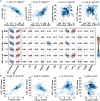Convergent Neuroimaging and Molecular Signatures in Mild Cognitive Impairment and Alzheimer's Disease: A Data-Driven Meta-Analysis with N = 3,118
- PMID: 38824231
- PMCID: PMC11365916
- DOI: 10.1007/s12264-024-01218-x
Convergent Neuroimaging and Molecular Signatures in Mild Cognitive Impairment and Alzheimer's Disease: A Data-Driven Meta-Analysis with N = 3,118
Abstract
The current study aimed to evaluate the susceptibility to regional brain atrophy and its biological mechanism in Alzheimer's disease (AD). We conducted data-driven meta-analyses to combine 3,118 structural magnetic resonance images from three datasets to obtain robust atrophy patterns. Then we introduced a set of radiogenomic analyses to investigate the biological basis of the atrophy patterns in AD. Our results showed that the hippocampus and amygdala exhibit the most severe atrophy, followed by the temporal, frontal, and occipital lobes in mild cognitive impairment (MCI) and AD. The extent of atrophy in MCI was less severe than that in AD. A series of biological processes related to the glutamate signaling pathway, cellular stress response, and synapse structure and function were investigated through gene set enrichment analysis. Our study contributes to understanding the manifestations of atrophy and a deeper understanding of the pathophysiological processes that contribute to atrophy, providing new insight for further clinical research on AD.
Keywords: Alzheimer’s disease; Brain atrophy; Gene set enrichment analysis; Meta-analysis; Structural magnetic resonance imaging.
© 2024. The Author(s).
Conflict of interest statement
The authors declare no conflicts of interest.
Figures





References
Publication types
MeSH terms
Grants and funding
LinkOut - more resources
Full Text Sources
Medical

